Efficient Road Prices - PowerPoint PPT Presentation
1 / 32
Title:
Efficient Road Prices
Description:
If facility is excludable at a reasonable price ... Until the marginal cost of an additional car. Is equal to the marginal benefit. Marginal cost ... – PowerPoint PPT presentation
Number of Views:23
Avg rating:3.0/5.0
Title: Efficient Road Prices
1
Efficient Road Prices
- Economics of Public PolicyPADM 625
- Ben Muse
2
Congestible public good
- Non-rival when there are not too many consumers
- But becomes congested as the number of consumers
gets larger
3
Bridges and roads
- Provide an example
- When traffic is light, a highway or a bridge may
approximate a non-rival state - Drivers dont interfere with each others use
- When traffic is heavy, they may approximate a
rival state - One driver use may also perfectly displace
another driver
4
What about excludability?
- Roads may be excludable or non-excludable
- Toll systems may be relatively inexpensive in
rural areas with few access points - Yet prohibitively expensive in urban areas with
lots of access points
5
Congestibility
- Use of the facility may change by day or time of
day - If facility is excludable at a reasonable price
- Efficiency may mean charging a price that varies
with the number of drivers
6
91 ExpressLanes
- Private firm
- Operates private toll road
- On the median of a state highway
- (competition with state highway prevents
monopoly)
7
(No Transcript)
8
(No Transcript)
9
Speed and congestion
- Relate average speed to the volume of traffic
- He uses the following formula
- S is average speed in miles/hour
- N is number of cars (in hundreds)
- S60 for N lt 5
- S300/N for N gt 5
10
Speed and congestion
- So, if there are 1000 cars on the road,
- N 10
- And S 300/10 30 miles per hour
11
How long to travel a mile?
- Speed in miles per hour is S300/N
- The time it takes to travel one mile is hours
per mile or 1/S - So we can relate the time to travel a mile to the
number of cars like this - 1/S N/300
- So if S 60 mph, 1/S 1/60 or a minute
12
Average cost to travel a mile
- The average time cost to travel a mile
- Will be equal to the product of
- The value of an hour of the drivers time
- And the time it takes to travel a mile
- AC W(1/S) W(N/300)
13
Average cost
- So
- If the drivers time is 10/hour
- And there are 400 drivers on the road
- So that the average speed is 60 mph
- The average cost per mile would be
- AC 10(1/60) 0.167
14
Average cost
- Note that, above 500 cars
- The AC increases by 3 1/3 cents for every
additional 100 cars
15
Graphing average cost
16
Marginal cost
- Marginal cost is very important
- Because we are going to want to add cars to the
road - Until the marginal cost of an additional car
- Is equal to the marginal benefit
17
Marginal cost
- Average cost
- AC W(N/300)
- Total cost
- Is equal to average cost per motorist times the
number of motorists - TC NW(N/300)
- Or TC W(N2/300)
18
Marginal cost
- The marginal cost of an extra driver is equal to
the first derivative of total cost with respect
to the number of drivers, N - TC W(N2/300)
- MC 2W(N/300)
- MC (2WN)/300 2AC
19
MC and AC
- According to the formula,
- MC 2AC
- So, if AC 5 cents, MC 10 cents
- If AC 10 cents, MC 20 cents
- Note this only holds above 500 cars
20
Adding marginal cost
21
Marginal benefit curve
- Now we need to look at the benefit side
- And add in a marginal willingness to pay curve
(MWTP)
22
Traffic with no toll
- With no toll, people will operate until their own
marginal benefit is equal to their cost (given by
the average cost curve) - But these people will be ignoring the costs
imposed on others by their activity (represented
by the marginal cost curve)
23
Adding marginal cost
24
The optimal traffic level
- Equates the marginal benefit a person receives by
traveling another mile - With the cost to them of traveling that mile,
plus - The cost they impose on others by traveling that
mile
25
Optimal toll and traffic
26
So,
- The optimal toll
- Will be equal to the distance between the average
cost curve and the marginal cost curve - And internalizes for the driver the costs
imposed on others
27
MWTP curve may change by day and hour
28
The optimal toll
- Varies by time of day
- When the MWTP curve is far to the right, demand
is heavy - The costs imposed on others by ones driving are
higher - And the optimal toll is higher
29
The optimal toll
- At night
- The MWTP curve is far to the left
- And, if it is positioned as shown
- The optimal toll is zero
- No congestion driving a mile is non-rival, a
positive toll would cut off valuable driving with
no gain.
30
Route 91 users
- No toll booths
- Members set up prepaid toll accounts
- Have transponders attached to their cars
- Overhead antennas and computers read
transponders, calculate toll for the lane, day,
time of day - Accounts are billed
31
(No Transcript)
32
Sources
- http//www.91expresslanes.com/learnaboutus.asp?pm
7 accessed on September 15, 2003. - Bruce, Chapter 3, Public Goods in Theory and
Practice































